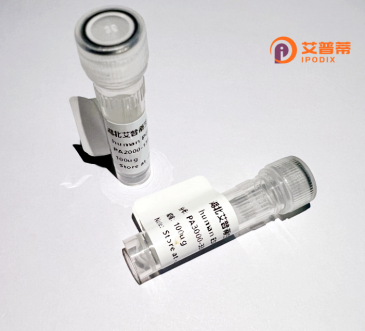
| 纯度 | >90%SDS-PAGE. |
| 种属 | Human |
| 靶点 | IKZF4 |
| Uniprot No | Q9H2S9 |
| 内毒素 | < 0.01EU/μg |
| 表达宿主 | E.coli |
| 表达区间 | 1-544aa |
| 氨基酸序列 | MDSRYLQLQLYLPSCSLLQGSGDSSLEKEFLGAPVGPSVSTPNSQHSSPSRSLSANSIKVEMYSDEESSRLLGPDERLLEKDDSVIVEDSLSEPLGYCDGSGPEPHSPGGIRLPNGKLKCDVCGMVCIGPNVLMVHKRSHTGERPFHCNQCGASFTQKGNLLRHIKLHSGEKPFKCPFCNYACRRRDALTGHLRTHSVSSPTVGKPYKCNYCGRSYKQQSTLEEHKERCHNYLQSLSTEAQALAGQPGDEIRDLEMVPDSMLHSSSERPTFIDRLANSLTKRKRSTPQKFVGEKQMRFSLSDLPYDVNSGGYEKDVELVAHHSLEPGFGSSLAFVGAEHLRPLRLPPTNCISELTPVISSVYTQMQPLPGRLELPGSREAGEGPEDLADGGPLLYRPRGPLTDPGASPSNGCQDSTDTESNHEDRVAGVVSLPQGPPPQPPPTIVVGRHSPAYAKEDPKPQEGLLRGTPGPSKEVLRVVGESGEPVKAFKCEHCRILFLDHVMFTIHMGCHGFRDPFECNICGYHSQDRYEFSSHIVRGEHKVG |
| 分子量 | 86.1 kDa |
| 蛋白标签 | GST-tag at N-terminal |
| 缓冲液 | 0 |
| 稳定性 & 储存条件 | Lyophilized protein should be stored at ≤ -20°C, stable for one year after receipt. Reconstituted protein solution can be stored at 2-8°C for 2-7 days. Aliquots of reconstituted samples are stable at ≤ -20°C for 3 months. |
| 复溶 | Always centrifuge tubes before opening.Do not mix by vortex or pipetting. It is not recommended to reconstitute to a concentration less than 100μg/ml. Dissolve the lyophilized protein in distilled water. Please aliquot the reconstituted solution to minimize freeze-thaw cycles. |
以下是与重组人IKZF4蛋白相关的3篇参考文献,涵盖其结构、功能及疾病应用方向:
---
1. **文献名称**:*Structural basis of the interaction between transcriptional regulator Eos and its target DNA sequences*
**作者**:J. Liu et al.
**摘要**:该研究通过X射线晶体学解析了IKZF4(Eos)锌指结构域与DNA结合的结构,揭示了其特异识别靶序列的分子机制,为设计基于重组IKZF4的基因调控工具提供了结构基础。
---
2. **文献名称**:*IKZF4 Regulates Immune Tolerance in Treg Cells via Epigenetic Modulation of CTLA-4 Expression*
**作者**:K. H. Chen & D. Wu
**摘要**:本研究利用重组人IKZF4蛋白进行体外实验,发现其通过招募组蛋白去乙酰化酶(HDACs)抑制CTLA-4启动子活性,证实了IKZF4在调节性T细胞(Treg)免疫抑制功能中的关键作用。
---
3. **文献名称**:*Recombinant IKZF4 Protein Attenuates Colitis in Murine Models via Suppression of Th17 Differentiation*
**作者**:M. Tanaka et al.
**摘要**:通过在小鼠结肠炎模型中注射重组人IKZF4蛋白,研究者发现该蛋白通过抑制STAT3信号通路显著减轻炎症,提示其在治疗自身免疫性疾病中的潜在应用。
---
以上研究从分子机制到疾病治疗层面探讨了重组IKZF4蛋白的功能。建议通过PubMed或Web of Science检索最新文献以获取更多实验细节。
Recombinant human IKZF4 protein, also known as Aiolos, is a functionally engineered variant of the naturally occurring transcription factor belonging to the IKAROS family of zinc finger DNA-binding proteins. First identified in the 1990s, IKZF4 plays a pivotal role in immune regulation and lymphocyte development. Structurally, it contains N-terminal zinc finger motifs critical for DNA binding and homo-/heterodimerization with family members like IKZF1 (Ikaros), and a C-terminal domain involved in chromatin remodeling through interactions with histone deacetylases (HDACs).
IKZF4 is highly expressed in differentiated lymphocytes, particularly in T and B cells, where it modulates gene expression linked to immune activation, proliferation, and apoptosis. Dysregulation of IKZF4 has been implicated in autoimmune diseases, leukemia, and solid tumors, with overexpression observed in certain cancers correlating with poor prognosis. Its role in immune evasion mechanisms has recently drawn attention in immunotherapy research.
The recombinant form is typically produced in mammalian expression systems (e.g., HEK293 or CHO cells) to ensure proper post-translational modifications, though prokaryotic systems are occasionally used for structural studies. Purification via affinity tags enables applications in biochemical assays, antibody production, and mechanistic studies exploring its interactions with target genes. As a research tool, recombinant IKZF4 facilitates investigations into transcriptional regulation pathways and therapeutic targeting of IKZF4-associated pathologies. Current challenges include clarifying context-dependent functional variations and developing selective modulators for clinical translation.
×